by Admin | Nov 27, 2014 | Math
It’s nice to have a few fun math picture books thrown in with your usual bedtime reading to help get kids thinking about math as part of their everyday world along with stories of pirates, animals or whatever happens to interest your kids. Here are a few books that my children and I have enjoyed lately that can help spark an interest in math concepts and ideas.
The Boy who Loved Math by Deborah Heligman and LeUyen Pham
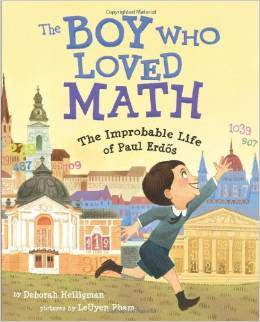
I love this book. It tells the story of Paul Erdős who had the most incredible life as a mathematician. He was a prodigy with two math professors for parents. His mother had lost two daughters to scarlet fever before Paul was born, and as a result she was extremely over protective with Paul, to the point that she didn’t want him going to school for fear of him picking up any germs. Staying at home and left to his own devices, he was able to develop his mathematical ability. Paul Erdős was so focused on thinking about math that he lived a very unconventional life, including never learning to butter his own bread, do laundry or drive a car. Instead he relied on friends and colleagues to take care of him, and in return he would travel around the sharing his knowledge with other mathematicians. He wanted to spend all of his time thinking about math. Paul Erdős was such an interesting figure because he lived the way that he wanted to live without regard for social convention, money, fame or status, which is a very appealing idea for kids (and adults!). He shared himself and his mind and he showed the world that math can be fun.
Bedtime Math Stories by Laura Overdeck and Jim Paillot
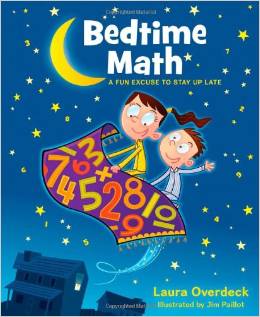
My kids can’t get enough of this book. The book is arranged into short stories about food, animals, vehicles, sports and odd jobs that are followed by questions to be answered. My 6 year old and my 9 year old are both able to take part in trying to figure out the answers to the mental math problems because for each story there are three levels of question to answer (Wee Ones, Little Kids, Big Kids). The only problem with this book is that it might keep your kids up late wanting to complete another story. Luckily there are two books in the series and judging from the success and how much my kids like these books there are sure to be more on the way. The illustrations are great and sometimes cute and funny. Highly recommend this book for anyone who wants to help get kids thinking about math. Check out their
website and a Facebook page.
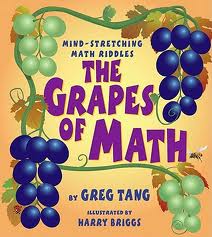 Greg Tang
Greg Tang has a whole series of fun math books. If you like
Bedtime Math the Greg Tang books are a little bit similar in style. He has written two books of math fables for the younger kids and a number of riddle based problems books for older children. You can read the books for free on his website, and be sure to check out the rest of the Greg Tang site for fantastic free math resources, especially the Kakooma section of the site; it is a lot of fun.
Math Curse by Jon Scieszka and Lane Smith
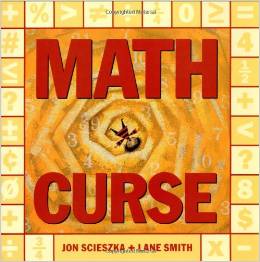
Math Curse is an older book, but it holds up well. It follows the idea of math in everyday life, and shows how it applies to everything. The books start with a teacher telling her class that “You can think of almost everything as a math problem”. The next day the main character wakes up and sees everything going on in her life as a math problem, so she thinks the teacher has put a math curse on her. It’s a fun, interactive book, that will help kids see how math relates to their daily lives and it introduces them to all sort of concepts like volume, time, fractions, measurement, and money in a humorous way. This book would be especially great for teachers.
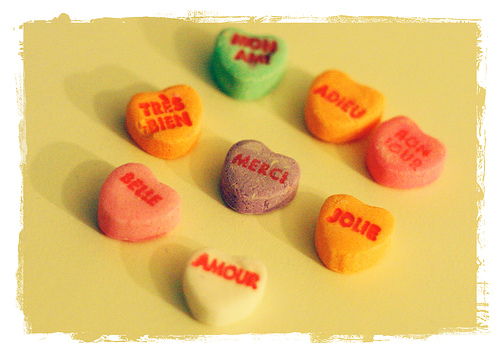
by Admin | Oct 29, 2014 | Languages
Everyone knows how beneficial it is to children’s brain development when they learn a second language, and so if you are looking for some ways to help introduce French to your children, there are some great resources around. Here is a list of our favorite mp3s, DVDs, books, websites, learning systems, and apps that will help your children learn this beautiful language.

DVDs to help Kids Learn Kids
There are few DVDs around to help teach kids French, but there aren’t really as many as you would think, and the quality of the DVDs can be pretty hit and miss. Here are a few of the better quality DVDs (check your local library there is a good chance they will have at least one or two of these):
- Bonjour Les Amis Vol. 1 is a simple 40 minute DVD that is good for kids ages 0-5. It introduces basic vocabulary that isn’t challenging, so it’s great for younger kids.
- French for Kids DVD Set: Simple Words & Number and Colours is a newer DVD with nice modern graphics. The words it introduces are very basic but serves as a good introduction for small kids.
- Little Pim French is a pretty good DVD for kids ages 0 to 5. There are six DVDs in the series that include topics “Eating and Drinking,” “Happy, Sad and Silly,” “In my Home,” Play,” “Wake up Smiling,” and “I Can Count.” The quality of the DVDs is high compared with other language DVDs we’ve come across. They have pleasant music, are engaging (our kids were very happy to watch the entire DVD), and there is the Panda Cartoon with silly segments mixed in with footage of kids performing everyday activities. The segments are arranged in five-minute episodes so you can watch the whole video or just a lesson or two depending on how your child is responding to it.
- Professor Toto is a DVD that you might want to have a look at for a child who is aged 6-12. With these DVDs, you get an English version of the DVD and also a French version of the DVD, so you watch a segment in French, then you replay that same segment in English, so the child becomes familiarized with the story. You also get a full script of what is said in the videos in both languages. Professor Toto was released in 2004, so the graphics look modern enough to keep kids engaged. The material is presented clearly and pronounced correctly, and it also has a lot of repetition and pleasantly catchy songs.
CDs/MP3s
An easy way to get kids used to a new language is to listen to a good CD or MP3. The more the kids hear a language, the more open they will be to the language as they get older. A couple of CDs that we have used and really like are Beth Manner’s Fun French for Kids and also the Beth Manners Magic French for Kids. These CDs (or downloads) are useful because they have a combination of lessons and super catchy songs.
Another good Audio CD/MP3 that you could try is French for Kids: Cha, Cha, Cha. This CD has fifteen songs about things like months of the year, numbers, vowels, etc. that are fun for kids. This CD is one of Dr. Toy’s top 10 educational toys for 2012.
Free Children’s Language Websites
For older kids, a great website to check out is DuoLingo. This is my new favorite language site. It is completely free, and there are no ads. It is a sort of gamified way of learning a language. You can set a daily goal that you want to achieve, and then you complete a lesson by mostly translating short phrases and answering questions. You can probably do this with a younger child if a parent is going to help the child with the lesson.
Since most kids love playing computer games, there is an excellent free game website for kids called French Games; it has topics, lessons, and games. Another fun site with games for kids is this Quia site. If you want even more games, you can always try these Play and Learn games.
A good site that has general activities and different lessons is this About page that is all about French education. It is very informative and has super useful tips and ideas on language education.
Radio Canada’s website has clips and short videos of some of its French-language programming, to help your kids get used to hearing spoken language.
Mama Lisa has a fantastic selection of French songs for kids, so if you need some free songs for kids, this is where you want to go.
For basic vocabulary lessons, an excellent site to try is Languages Online. Or another site with a similar setup is Language Guide. It lets kids practice their vocabulary, expressions, the alphabet, and numbers. You can listen to all the vocabulary aloud and then test your audio comprehension and speaking skills.
YouTube has a great selection of online lessons that your kids can watch, a series or channel that I like a lot for kids is this one from Frencheezee.
Kids who know a bit of the language already might like Du Plaisir à Lire. It has games and activities.
Books to Help Kids Learn
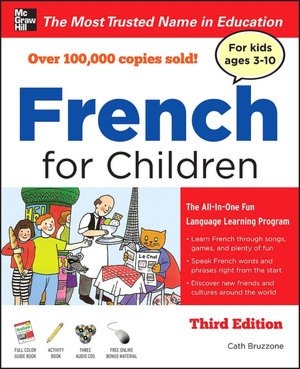
French for Children is a great book that has a mix of written and spoken language. Of all the books that we bought, this was the one that our kids enjoy looking at and listening to the most. It’s got fun lessons and quizzes as well the cd is another excellent option to bring along in the car.
The Everything Kids’ Learning French Book The Everything Kids series is always a good investment for most topics that may want to learn about. This book is no exception. It has a lot of fun activities that will keep your kids motivated and excited about learning.
Language Learning Systems
There are a lot of language systems around that are marketed toward teaching kids new languages, most of them are pretty old and not that great, you would be better off watching a few YouTube videos and looking at websites. Having said that there are a couple of newer language systems that are quite popular including:
- PetraLingua is an online multimedia language course for kids aged 3-12. They have language lessons with videos. They have some free content as well as paid. You can do this course through DVDs or online.
- Dino Lingo This is a bit of a pricey course (around $160), but the idea of it is that it is a fully immersive course, so it includes a lot of different materials. The system uses DVDs, books, flashcards, games, songs, and online lessons, so your child can have an immersive experience with lots of different options to help them learn.
- Wink to Learn is a whole language system that uses flashcards, and DVDs or Streaming Video. You can try out a free trial or the sites streaming video or digital flashcards.
Apps
- Learn French – MindSnacks is a fun educational app that uses mini-games to teach and re-enforce vocabulary. If you are getting this for a child, they will need to have some knowledge of French, and they will need to be able to read and write. Cost: Free for the first level. You can upgrade for $4.99 to get all 50 levels. For use on iPhone, iPod Touch, iPad Age: 10+
- French Baby Flash Cards has Educational Baby Flash Cards features over 450 high-quality images with text and voiceovers. Cost: Free with in-app purchases available. For use on iPhone, iPod touch, and iPad.
- play2learn French HD COMPLETE lets kids explore words by tapping an item on the screen to hear its name pronounced by the speaker. Cost:$ 1.99 with additional content available as In-App purchase – 18 extra sets in 3 bundles. For use on iPad.
- Play & Learn French – Speak & Talk Fast With Easy Games includes Game Mode and Learn Mode and has over 700 everyday words and phrases to explore. Cost $2.99. For use on iPhone, iPod touch, and iPad.
photo credit: Ani-Bee via photopin cc
by Admin | Oct 23, 2014 | Music
If you have been thinking about teaching your child to play guitar yourself and aren’t quite sure where to start, this is the post for you. There are some great resources around that can help you teach your children to play without having to shell out for costly music lessons. Here are some of the best books, free online classes for kids, DVDs, and software to help get you started.
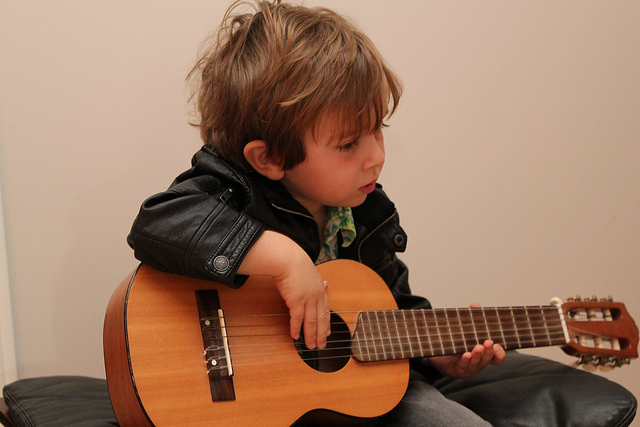
What age can kids begin learning?
It depends on the child. If your child has shown an interest in learning to play, there are lots of great ½ and ¾ size instruments (both acoustic and electric) for very young children. If you are teaching your kids yourself, you will want to make sure they want to learn, they can sit and concentrate, and they have a guitar that is an appropriate size for their age. If they are playing something too big, it will make it very difficult for them to play comfortably.
Where to Start
Many introductory lessons for kids follow the same basic outline listed below. If you don’t play yourself, skip down to the free classes listed in the next section, both cover most of these topics.
- Go over all the parts of the instrument with your kids. Explain to them what everything is called and what it does.
- Show your kids how to hold the guitar. Where should their hands be positioned and how to hold and use a pick. Pretty basic, but you want to get this right at the beginning.
- Tuning- Show your child how to tune the instrument. This might be a little intimidating for some kids, but it is a skill that they need to learn, and again there are lots of great videos online about how to do this with or without a tuning machine.
- Explain what chords are, why they need to learn them, and show them how to read chords.
- Once they understand chords, you can begin to teach them simple songs.
Free Online Lessons for Kids
- Little Kids Rock put up some handy free online lessons for kids that you can check out. The instructor goes through some of the basics, including tuning, and some of the chords. Little Kids Rock is dedicated to making sure every kid gets a first-rate music education, so they have lots of excellent free resources that you can take advantage of. This organization is supported by a tonne of huge names in music like Metallica, Slash, Steven Van Zandt, Lady Gaga, the list goes on and on.
- Kids Guitar Zone has lots of free lessons that go over everything that kids need to learn to get started playing. Lesson 1 alone has videos on parts, the proper holding position, tuning, how to read tablature, and how to practice. It’s a fantastic, well-organized site that is super useful for parents and kids.
Best Books to Teach a Child Guitar
If you are old school like me, you will want to have a couple of method books to refer to and to help your kids learn a bit of theory. There is an excellent selection of method books that are written specifically for kids, so they are easy and fun to go through. Here are a few of the most recommended:
- Kid’s Guitar Course, Book 1 is a method book for kids ages five and up. It is the number one selling kids method book. People like it because it uses simple language that kids can understand, and it has a few different cartoon dogs and an alligator (who likes the blues!) It goes over how to play cords and melodies and how to read music. It also includes a CD. This is an excellent choice for parents who are looking for a beginner book to teach kids at home since it covers all the basics and you the CD and DVD that are super helpful.
- Another top-rated beginner book is Guitar for Kids for Ages 5-9 (Hal Leonard Guitar Method. It is an easy course that teaches children to play quickly. It has lots of sixties songs that your kids might already know like Yellow Submarine, I’m a Believer and Hound Dog. This method is suitable for electric or acoustic and is also okay for teachers or parents, even if they’ve never had any musical training themselves. The CD that comes with it contains more than 30 tracks for demonstration and play-along.
- My First Guitar: Learn To Play: Kids by the very prolific author Ben Parker is a very kid-friendly introduction, especially for parents with no musical background. The lessons cover: how to hold it, how to use a pick, tuning, chords, and strumming, how to read chord diagrams. Then it shows kids how to play some of the favorite childhood songs like Wheels on the Bus If You’re Happy and You Know It, Old MacDonald Had a Farm, etc.
DVDs and DIY Courses
If you are looking for a bit more instruction or a more complete package type course, there are a few around that are suitable for beginners.
- Kid’s Guitar Course Complete, This course for kids, has a book, enhanced CD, and a DVD, and it is for teaching the basics to 5-9-year-olds. It also contains activity worksheets to help learn how to read music.
- My Guitar is a decent DVD that has an animated character named Gary, who helps children go through over 50 lessons written by a professional instructor. This DVD goes over all the basics, like how to hold and tune the instrument, it also shows kids how to strum chords, read tablature, and even goes over how to play a few simple songs. The DVD includes a link to a bonus download tool kit with an automatic tuner, metronome, chord dictionary, and digital recorder that can be used on your computer.
Software
Rocksmith is a learning music game that is designed for adults, but some older kids might find it a good tool to help them learn. It is kind of like Guitar Hero, but you use a real guitar that you plug into the game console using a cable that comes with the game. I’m not sure what would be the youngest you can go with Rocksmith, probably no younger than ten years old depending on the child. My nine year old just couldn’t get into it, but I have seen reviews and comments where people have said they had kids ages as young as 8 playing it. Some of the lyrics are a bit PG-13, so it isn’t for everyone. The game has over 50 rock songs to play along with, along with as well as lessons and mini-games.
by Admin | Oct 22, 2014 | Music
The small size of the ukulele makes it the perfect first instrument for most children. In recent years ukes have gained popularity, particularly in schools, as a great instrument to help develop kid’s musical abilities. They aren’t very hard to learn, are relatively inexpensive, and are super FUN! So here’s our little guide for getting you going if you want to teach your child to play this fantastic instrument.
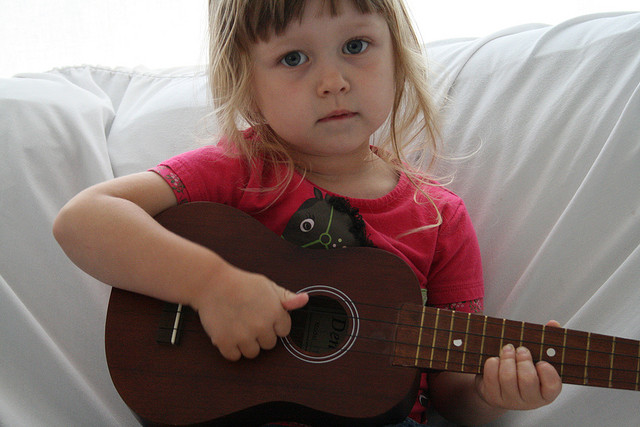
What is a good starter ukulele for kids?
If you haven’t chosen an instrument yet, you might want to start on a soprano uke. Soprano ukes are the smallest size of ukulele, the other sizes being concert, tenor, and baritone. Music teachers often recommend this one from Kala, people like them because they are built well, are reasonably priced and sound really good. Since we are talking about kids, color can be an important factor when making a purchase, so another highly recommended uke for kids is the Kala Makala Dolphin Soprano Ukulele, it comes in something like eight colors and kids will really love the look of it. It’s also generally regarded as one of the best starter models around.
If you are thinking about getting a toy store brand starter pack, please consider going to a music store and having a look there first. Music store brands are only slightly more expensive than toy/big box store brands, but they are worlds apart as far as quality is concerned. If you get your child a bad quality instrument, it will be harder for them to play and less likely that they will stick with it.
What age can children start playing the ukulele?
The best age to begin a child on an instrument is when they show an interest in it. If you try to force a child to learn an instrument they have no desire to play, you won’t get very far, especially if you are teaching them at home. You can try to spark an interest in playing by showing kids different models at music stores and letting them play, or showing them online videos of other children playing. It is possible for kids as young as age 3 to learn a musical instrument, but a good starting age for ukulele is generally age 6 and up.
What are the basic skills to start with?
If you are teaching your kids at home, start with the easy stuff.
- Go over the parts of the instrument. If you aren’t sure about the parts, here is a good article and diagram on what is what.
- Show your child how to hold the ukulele.
- Tuning –Knowing how to tune your instrument is pretty important. There is a simple, quick video here on how to do that.
- What are chords
- How to strum
Read More: 20 Fun Resources to Teach Kids How to Read Music
Websites
There are some fantastic resources if you want to learn more about teaching kids. Great places to start are these websites:
- Ukulele 4 Kids has a ton of resources for kids who are learning or thinking about learning to play. It has great info on how to do A, C, F, and G chords. The site also has reviews on Software, books, DVDs, and links for songs and videos.
- Ukulele in the Classroom This site is primarily for music teachers, but it does have really good free, supplementary materials and teaching aids for classroom use that can also be used at home if you are really keen.
The Best Ukulele Books for Kids
With the popularity of the ukulele growing every year, it’s not hard to find a beginner book that your kids will love. There are quite a few books that are great for teaching kids, here are some of the most popular:
- My First Ukulele For Kids: Learn To Play: Kids is one of the newer intro books for kids written by the very popular music author Ben Parker. It covers basic info about the including its parts and a bit about the history. It gives practical lessons on using a pick, tuning and chords and strumming. There is also information on how to read chord diagrams and how to actually play the chords. It is written in a very simple way that children will have no trouble following along with.
- Kid’s Ukulele Course 1: The Easiest Ukulele Method Ever! is a method book, CD, and DVD combo that can help kids learn to play songs right away. This set comes with a book, CD, and a DVD that covers how to hold the instrument and tune the strings. It also shows kids how to strum chords, read music, and playing songs like Ode to Joy, Over the Rainbow, and When the Saints Go Marching In. The DVD teaches kids how to play along with notes displayed on the screen, and the CD and DVD give kids a reference on how the notes are supposed to sound.
- Jiminy Kokopo’s Ukulele Sing and Strum Fun Book This is a fun and educational music book, it doesn’t take itself too seriously, so it’s a good choice for kids. It covers everything a beginner player needs to know, including history, diagram of the parts, how to hold it, strumming, and tuning. Fun Book combines the fun of ukulele playing with theory. Kids will really like the crazy potato comics.
- Mel Bay presents Children’s Ukulele Method Book/CD Set by Drew Andrews is an older method for children and beginners. Since it is put out by Mel Bay, you can expect a pretty standard method book covering all the basics like how to read the notes, proper holding technique, strumming and picking, and lots of popular songs. This isn’t my favorite of the method books, I find it a little dry, so I wouldn’t put it as my first choice of books to get, but if you like the Mel Bay style then definitely check it out. It does come with a CD that has the songs that are in the book.
- Ukulele for Kids – Hal Leonard Ukulele Method Series is another good option if you are looking for a method book that you can use at home to introduce your kids to the ukulele. There are lots of songs that parents will know, maybe not so many that kids will recognize like Yellow Submarine, This Land Is Your Land, Rock Around the Clock, You Are My Sunshine, and Barbara Ann. This book comes with a CD that has tracks for demonstration and play-along. Some of the lessons are parts of the uke; holding the instrument; hand position; reading music notation and counting; notes on the strings; C, F, C7, Am, G, B-flat, and Gm chords; strumming and picking.
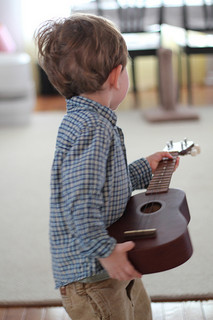
Free Online Ukulele Lessons
If you aren’t quite up for the method books, here are some great free online lessons for kids. Honestly, the best place to find free lessons is on YouTube (as you probably already know). There are so many free good quality lessons available you shouldn’t have any trouble finding something that is right for your kids there. Here are a few other lessons to help get you started:
- Motleumuse this is a great little series of lessons from a school music teacher.
- Madeline’s Ukulele Class talks about the parts of the uke, how to tune it with an electronic tuner, how to play in the fret, the c chord, and how to strum.
- Ukulele Lessons for Kids this girl goes over what you need to know to play the uke.
Read More: What you need to Know to Teach your Kid Guitar
by Admin | Oct 21, 2014 | Music
We all know that piano lessons can often be costly, so we thought why not try to find out what resources are available to parents who would like to teach their children how to play at home. Thanks to the internet and technology in general, there is a fantastic amount of tools that parents can use to guide their children and help them learn this wonderful instrument without having to spend a lot of money on lessons.
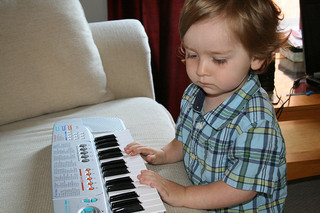
Is it possible for parents to teach their kids at home?
Of course, the ideal is to have a music teacher, but for some families taking formal lessons is not possible due to cost or location. If parents are motivated to help their children learn, and kids are willing to practice and put in the work, there is no reason that a child won’t be able to learn the same basic theory that young children who are taking introductory classes are.
How much will learning to play the cost?
The cost can vary quite a bit, there is the initial cost of an acoustic or a digital piano (if you don’t already have one) as well as a stool or bench. If you are purchasing a digital keyboard, you will also need to get a keyboard stand. It would also be useful to invest in a few good method books, as well as an online software method that you can get for a range of different prices.
What age should children begin to learn?
It is possible for kids as young as age 3 to begin to learn to play. Although most teachers won’t accept children for lessons until they are at least 5 years old. At age five, children’s hands are big enough to play the keys comfortably, and they are developmentally ready to sit still and concentrate. So five is probably a good starting age, but you can obviously start much later depending on what you think your child is capable of.
Should kids learn on a digital or an acoustic piano?
If you already have one or can get your hands on one, an acoustic is the better option for kids to learn on. However, realistically most kids these days learn on a digital. They are cheaper, take up less space, and are more portable.
For those parents who have their heart set on getting an acoustic and you want to buy new, you will be looking at a starting price for an upright piano at about $3000. If you are willing to look at used instruments, you can get them for much less. Check Craigslist and Kijiji and also ask family and friends if they have a piano that they aren’t using and might be willing to lend, give, or sell to you. If you don’t have a player in the house, a piano can be a bit of a burden for some people, so you never know.
Parents who have decided on getting a digital should look for an instrument that is as close to the feel of an acoustic as possible. To do this, you need to get a digital piano that has weighted or at least semi-weighted keys. If you are able to get a digital with weighted keys, then your kids will be able to transition between an acoustic and a digital much quicker. Unfortunately, digital instruments with weighted keys are more expensive than those that don’t have weighted keys, but they do come the closest to the feel of an acoustic. If you live near a music store, it is a good idea to try out a few different models to see what suits your child, as well as getting a feel for how the keys are weighted.
Before Beginning
Any families that are using an acoustic will need to make sure that it has been tuned before starting your lessons. You will also need to have a stool or bench that is height adjustable. Sitting at the correct height will make it much more comfortable and easy for your child to learn.
Your child should also know their alphabet (at least from A to G) and be able to tell you which is their right and which is their left side. If your child is very young and they don’t know right and left and their alphabet, don’t worry, there are a few resources that we will discuss later in the post that is good for very young children.
How much time should be spent on lessons in a week?
If you are teaching your kids at home, take it seriously by setting aside a particular time and day of the week for a formal lesson for half an hour. Then have your child do 15 minutes of practice a day or every other day, depending on what works best for you. Getting your kids into a good practice routine takes a lot of time and disciple, but with a bit of effort, your kids will hopefully get to a point that they will begin to take responsibility for their practice sessions themselves.
How to Teach Piano to Kids
There is no definitive method that is the best way to teach kids to play, an approach that might work for one child might not work for another depending on different learning styles.
Figuring out how to start can be a bit tricky since there are a few different approaches you can take. If you would like a more hands-on approach, there are wonderful introductory method books that are used by music teachers but can be used by parents as well, they tend to go over note names on the staff and basic scales, finger exercises, chords, and songs. If you don’t have a strong musical background, you can use educational music software or online lessons to help guide your child (see below for more info).
Read More: 20 Fun Resources to Teach Kids How to Read Music
Learn to Play Software for Kids
In the last few years, there have been some really interesting software and websites that have been developed that gamifies music learning or have hundreds of video music lessons that seem to be following in the trend of MOOC structure that a lot of learning is heading towards. It is a very interesting development, especially for families who aren’t in a position to be able to afford traditional music lessons for their kids. As with regular lessons, it takes dedication and lots of practice, but children can definitely learn a lot through some of the new technology that is coming out.
- Piano Marvel is a very popular music teaching and assessment software that you can use without a teacher. Students play along with the computer and receive scores that earn them bronze, silver, and gold trophies, which are placed into their own virtual trophy case. Immediate feedback is given so that students know exactly how to improve their performance. Correct notes turn green while wrong notes turn red and show whether a note was played late, early, or in the wrong key. It combines elements of computer gaming with instrument practice. Kids can learn on their own at their own pace. It has over 3,000 songs and exercises designed to challenge everyone from beginners to professionals. Video Tutorials are provided to guide students on the fundamentals of playing; including hand positions, finger placement, dynamics, music reading skills, and much more. Piano Marvel offers a 30 free trial, and it costs $15 a month if you decide to sign up. To use it, you need a midi keyboard that you can attach to your computer.
- Playground Sessions is a fairly new teaching software (put out in 2013) that has the backing of Quincy Jones. It is perhaps better suited towards an older child than Piano Marvel, but it is worth having a look at because it is a little bit cheaper than Piano Marvel. The program itself is based on a play to learn model that has students playing popular songs right away while using the songs to teach music theory. There are also tutorials with lessons for beginner, intermediate, and advanced skill levels. Some of the topics the lessons cover include keyboard skills, notation, playing by ear, and rhythm. The way that the software gamifies learning to play by giving a score for how well students play on a note-by-note basis, and by song. Students can also earn badges by completing challenges. To use the software, you need a keyboard that connects to your computer. You can use Playground Sessions as a member or a non-member. If you get a membership, the cost is $9.99/month for 12 months (billed annually) or $14.99/month for 3 months (billed quarterly). As part of this price, you get full access to the Playground software and community, all Bootcamp lessons for free, and major discounts on songs and sheet music. If you don’t want to sign up for a membership, you can still buy the Bootcamp lesson packages a la carte (prices range from $39-89) and individual song lessons and sheet music for full price ($4.49-$14.99).
- Synthesia is a video game and keyboard trainer for Microsoft Windows and Mac OS X, which allows users to play a MIDI keyboard or use a computer keyboard in time to a MIDI file by using a falling note system, it is a little bit like Guitar Hero. You can also use it with MIDI keyboards that have illuminated keys, which can make learning easier for beginners. You can try it for free or buying a learning pack for $29.
- Online Classical Piano School doesn’t have any of the gaming aspects of Synthesia, Playground Sessions, or Piano Marvel, and it is the most like a traditional lesson. The lessons are focused on classical piano and are taught by Christie Peery, who is an accomplished solo artist. For around $30 a month, you get a curriculum developed by Peery that uses video exchange lessons that teach traditional music theory concepts, sight-reading, improvisational playing, and more.
Piano Books for Kids
We have rounded up some of the best method books that are generally used by music teachers to teach introductory piano to children. The cool thing about these introductory books is that they are so simple that a parent could learn along with the child as well as teaching at home. Most of these books only provide an introduction, so you will have to find another program afterward, but these books will give a great foundation for kids who are just starting.
Alfred’s Basic Piano Library: Prep Course Lesson Level A – These top-rated books are often used by teachers with their students. The lessons in the book build upon music theory, not only teaching children how to play but teaching them the theories behind the music. These are simple, fun, wonderfully illustrated books that are very self-explanatory at the early levels. The songs at the beginning level are silly, but they allow the student to really learn the basics.
Music for Little Mozarts by Christine Barden is another very popular selection for music teachers to use with students. Parents with no musical background can use this method as it is very simple and great for very young kids. There is an app based on Music for Little Mozarts as well.
My First Piano Adventure, Lesson Book A with CD (ages 5-6), and Writing Book A are a couple of books written by Nancy and Randall Faber. My First Piano Adventure books are designed to begin use around age five and are used by many teachers for their students. When you complete My First Piano Adventure, you can move on to Piano Adventures. The Faber and Faber series for reading able children is a curriculum that you could easily do with your children as it goes through everything step by step, even if you have no musical background. This particular set of books is geared toward a younger player, but they also have a line of books for older children as well
Easiest Piano Course Complete and Teaching Little Fingers to Play: A Book for the Earliest Beginner by John Thompson are great beginning programs designed to be used with a child as young as four to five years old. These books combine a rote memory and note approach to playing, and they have nicely illustrated pages that are appealing to young children.
Piano-K, Play the Self-teaching Piano Game for Kids. Level 1 This is a bit of a different approach than the books listed above. Piano-K is a self-teaching game-book for children that does not require any previous music skills. It uses animals’ stickers to show kids how to associate the notes on the keyboard with their places and names in the score.
Free Online Piano Lesson for Children
Here are a couple of free alternatives to help your kids learn if you aren’t up for spending any money:
Other resources children can use:
Piano for Kids at Home offers a few free lessons to try out, and then you can become a member of the site for $10 a month. If you become a member you get access to more games, pictures, stories, and other fun stuff to help maintain interest in the instruction.
Hopefully, you have found something that will help your kids learn to play the piano, let us know if you have any useful resources to add to our list.
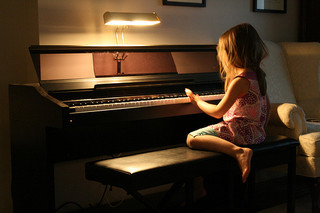
 I love this book. It tells the story of Paul Erdős who had the most incredible life as a mathematician. He was a prodigy with two math professors for parents. His mother had lost two daughters to scarlet fever before Paul was born, and as a result she was extremely over protective with Paul, to the point that she didn’t want him going to school for fear of him picking up any germs. Staying at home and left to his own devices, he was able to develop his mathematical ability. Paul Erdős was so focused on thinking about math that he lived a very unconventional life, including never learning to butter his own bread, do laundry or drive a car. Instead he relied on friends and colleagues to take care of him, and in return he would travel around the sharing his knowledge with other mathematicians. He wanted to spend all of his time thinking about math. Paul Erdős was such an interesting figure because he lived the way that he wanted to live without regard for social convention, money, fame or status, which is a very appealing idea for kids (and adults!). He shared himself and his mind and he showed the world that math can be fun.
Bedtime Math Stories by Laura Overdeck and Jim Paillot
I love this book. It tells the story of Paul Erdős who had the most incredible life as a mathematician. He was a prodigy with two math professors for parents. His mother had lost two daughters to scarlet fever before Paul was born, and as a result she was extremely over protective with Paul, to the point that she didn’t want him going to school for fear of him picking up any germs. Staying at home and left to his own devices, he was able to develop his mathematical ability. Paul Erdős was so focused on thinking about math that he lived a very unconventional life, including never learning to butter his own bread, do laundry or drive a car. Instead he relied on friends and colleagues to take care of him, and in return he would travel around the sharing his knowledge with other mathematicians. He wanted to spend all of his time thinking about math. Paul Erdős was such an interesting figure because he lived the way that he wanted to live without regard for social convention, money, fame or status, which is a very appealing idea for kids (and adults!). He shared himself and his mind and he showed the world that math can be fun.
Bedtime Math Stories by Laura Overdeck and Jim Paillot
 My kids can’t get enough of this book. The book is arranged into short stories about food, animals, vehicles, sports and odd jobs that are followed by questions to be answered. My 6 year old and my 9 year old are both able to take part in trying to figure out the answers to the mental math problems because for each story there are three levels of question to answer (Wee Ones, Little Kids, Big Kids). The only problem with this book is that it might keep your kids up late wanting to complete another story. Luckily there are two books in the series and judging from the success and how much my kids like these books there are sure to be more on the way. The illustrations are great and sometimes cute and funny. Highly recommend this book for anyone who wants to help get kids thinking about math. Check out their website and a Facebook page.
My kids can’t get enough of this book. The book is arranged into short stories about food, animals, vehicles, sports and odd jobs that are followed by questions to be answered. My 6 year old and my 9 year old are both able to take part in trying to figure out the answers to the mental math problems because for each story there are three levels of question to answer (Wee Ones, Little Kids, Big Kids). The only problem with this book is that it might keep your kids up late wanting to complete another story. Luckily there are two books in the series and judging from the success and how much my kids like these books there are sure to be more on the way. The illustrations are great and sometimes cute and funny. Highly recommend this book for anyone who wants to help get kids thinking about math. Check out their website and a Facebook page.
 Greg Tang has a whole series of fun math books. If you like Bedtime Math the Greg Tang books are a little bit similar in style. He has written two books of math fables for the younger kids and a number of riddle based problems books for older children. You can read the books for free on his website, and be sure to check out the rest of the Greg Tang site for fantastic free math resources, especially the Kakooma section of the site; it is a lot of fun.
Math Curse by Jon Scieszka and Lane Smith
Greg Tang has a whole series of fun math books. If you like Bedtime Math the Greg Tang books are a little bit similar in style. He has written two books of math fables for the younger kids and a number of riddle based problems books for older children. You can read the books for free on his website, and be sure to check out the rest of the Greg Tang site for fantastic free math resources, especially the Kakooma section of the site; it is a lot of fun.
Math Curse by Jon Scieszka and Lane Smith
 Math Curse is an older book, but it holds up well. It follows the idea of math in everyday life, and shows how it applies to everything. The books start with a teacher telling her class that “You can think of almost everything as a math problem”. The next day the main character wakes up and sees everything going on in her life as a math problem, so she thinks the teacher has put a math curse on her. It’s a fun, interactive book, that will help kids see how math relates to their daily lives and it introduces them to all sort of concepts like volume, time, fractions, measurement, and money in a humorous way. This book would be especially great for teachers.
Math Curse is an older book, but it holds up well. It follows the idea of math in everyday life, and shows how it applies to everything. The books start with a teacher telling her class that “You can think of almost everything as a math problem”. The next day the main character wakes up and sees everything going on in her life as a math problem, so she thinks the teacher has put a math curse on her. It’s a fun, interactive book, that will help kids see how math relates to their daily lives and it introduces them to all sort of concepts like volume, time, fractions, measurement, and money in a humorous way. This book would be especially great for teachers.






